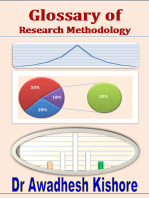0 ratings0% found this document useful (0 votes)
443 viewsData Analysis Template 20131125 PDF
This document provides a template for a data analysis plan for an observational study. It includes sections for background information on the study, research questions and hypotheses, study design details, the proposed analytical strategy, and plans for interpreting and disseminating the results. The template requests information on the study population, inclusion/exclusion criteria, variables, analytical models, and approach to dealing with missing data. It also recommends including concept maps or directed acyclic graphs to visualize hypotheses and potential confounders.
Uploaded by
datadobCopyright
© © All Rights Reserved
Available Formats
Download as PDF, TXT or read online on Scribd
0 ratings0% found this document useful (0 votes)
443 viewsData Analysis Template 20131125 PDF
This document provides a template for a data analysis plan for an observational study. It includes sections for background information on the study, research questions and hypotheses, study design details, the proposed analytical strategy, and plans for interpreting and disseminating the results. The template requests information on the study population, inclusion/exclusion criteria, variables, analytical models, and approach to dealing with missing data. It also recommends including concept maps or directed acyclic graphs to visualize hypotheses and potential confounders.
Uploaded by
datadobCopyright
© © All Rights Reserved
Available Formats
Download as PDF, TXT or read online on Scribd
You are on page 1/ 3
Example Data Analysis Plan
Template
For Observational Studies
Last updated 25 November 2013
Research School of Population
Health
ANU College of Medicine, Biology &
Environment
Example Data Analysis Template
Note: This data analysis template is a modified version of the template created by the
Master of Philosophy (Applied Epidemiology) teaching team at the Australian National
University.
DATA ANALYSIS PLAN
TEMPLATE
Reference No.
Date of plan
Person conducting
analysis
Study name
Chief investigator
Telephone
Mobile
Email
Analysis team
members
Background to the study and analysis
(Please use plain language)
Provide an overview of the necessary background for the study including evidence of what is
already known in the area of study and what the gaps are in the literature. Finish with a clear
stated aim of the project.
Number study
participants
Study research
question
Specific hypothesis
under study
Endpoints or
outcomes of interest
Duration of study
Data details
(Please complete all that apply)
Study type
Data sets used
Analysis package
Study population
Inclusion/exclusion criteria
for participants
Exposure variables
Outcome measures
Covariates
Sub-groups
Page 2 of 3
Approach to dealing with
missing data
Please outline proposed analytical strategy
Include:
Outline of main comparison groups
Frequency and cross-tabulations of main variables
Basic analysis model (usually age- and sex-adjusted)
Final analysis model (including adjustment for other confounders)
Analysis dissemination strategy
Outline the intended steps to be taken to disseminate the results of the study (i.e. will the
results be published, presented at a conference etc)
Interpretation
Detail how you will interpret the results in the context of your stated hypothesis. I.e. if the
results do/do not meet your hypothesis, what will you conclude? A concept map (see below)
may assist with this.
Concept map or directed acyclic graph
Drawing a diagram of the ways in which the exposure might be related to the outcome will
help to visualise your hypotheses as well as serving as a basis for clearly communicating
this to your collaborators. The diagram should include the possible confounders or mediators
of the relationship. This will require good knowledge of the background to the study.
Directed acyclic graphs are a type of causal graph. Further information about these graphs
can be found through a Google search and in the paper Causal Diagrams for Epidemiologic
Research by Sander Greenland, Judea Pearl, and James M. Robins (Epidemiology
1999;10:37-4)
Dummy tables & Charts
Dummy tables and charts are empty skeleton tables and charts which show how the results
will be presented but which do not contain any data/results.
Page 3 of 3
You might also like
- 14 Days Quarantine Plan in Canada: Personal Details100% (1)14 Days Quarantine Plan in Canada: Personal Details2 pages
- Certified Information Privacy Technologist A Complete GuideFrom EverandCertified Information Privacy Technologist A Complete GuideNo ratings yet
- Statistical Design and Analysis of Experiments: With Applications to Engineering and ScienceFrom EverandStatistical Design and Analysis of Experiments: With Applications to Engineering and ScienceNo ratings yet
- Creating-Analysis-Plan PW Final 09242013No ratings yetCreating-Analysis-Plan PW Final 0924201345 pages
- Lesson 1 - Roles of Statistics and Data AnalysisNo ratings yetLesson 1 - Roles of Statistics and Data Analysis5 pages
- Writing Statistical Section and Presentation of Results - Juliana NamutunduNo ratings yetWriting Statistical Section and Presentation of Results - Juliana Namutundu37 pages
- Method of data analysis presentation and interpretationNo ratings yetMethod of data analysis presentation and interpretation12 pages
- Module-for-Blended-Thesis Writing Lesson 16No ratings yetModule-for-Blended-Thesis Writing Lesson 169 pages
- 7 - Data Collection, Analysis & InterpretationNo ratings yet7 - Data Collection, Analysis & Interpretation35 pages
- Data Management and Analysis Using JMP: Health Care Case StudiesFrom EverandData Management and Analysis Using JMP: Health Care Case StudiesNo ratings yet
- Quantitative Method-Breviary - SPSS: A problem-oriented reference for market researchersFrom EverandQuantitative Method-Breviary - SPSS: A problem-oriented reference for market researchersNo ratings yet
- Introduction To Business Statistics Through R Software: SoftwareFrom EverandIntroduction To Business Statistics Through R Software: SoftwareNo ratings yet
- FETPI2.0 d20 Data Planning Management 2020-06No ratings yetFETPI2.0 d20 Data Planning Management 2020-0662 pages
- PRACTICAL RESEARCH 1: How To Conduct Data AnalysisNo ratings yetPRACTICAL RESEARCH 1: How To Conduct Data Analysis2 pages
- Anna University:: Chennai - 600 025: Office of The Controller of ExaminationsNo ratings yetAnna University:: Chennai - 600 025: Office of The Controller of Examinations52 pages
- Hayek and Scientism - by Joseph BelbrunoNo ratings yetHayek and Scientism - by Joseph Belbruno17 pages
- GIS Professionals Training Info 20191006 v2 UpdatedNo ratings yetGIS Professionals Training Info 20191006 v2 Updated4 pages
- Practical Research1 Q2 M6 and M7 Week 3 4No ratings yetPractical Research1 Q2 M6 and M7 Week 3 410 pages
- 2.1ATOMIC STRUCTURE - STUDENT - ppt16 - 17 PDF0% (1)2.1ATOMIC STRUCTURE - STUDENT - ppt16 - 17 PDF67 pages
- De La Garza Toledo-La Epistemologia Critica y El Concepto de Configuracion50% (2)De La Garza Toledo-La Epistemologia Critica y El Concepto de Configuracion20 pages
- Management Research After Modernism, Andrew M. PettigrewNo ratings yetManagement Research After Modernism, Andrew M. Pettigrew10 pages
- A Vision of Transdisciplinarity Laying Foundations For A World Knowledge Dialogue 1st Edition Frederic Darbellay100% (16)A Vision of Transdisciplinarity Laying Foundations For A World Knowledge Dialogue 1st Edition Frederic Darbellay84 pages
- How To Publish Paper in Scopus Indexed JournalsNo ratings yetHow To Publish Paper in Scopus Indexed Journals60 pages
- FALLSEM2023-24 SWE2020 ETH VL2023240103291 2023-11-22 Reference-Material-IINo ratings yetFALLSEM2023-24 SWE2020 ETH VL2023240103291 2023-11-22 Reference-Material-II26 pages
- Dominant Approaches and Ideas - Part 2: Human-Environment SystemsNo ratings yetDominant Approaches and Ideas - Part 2: Human-Environment Systems2 pages
- Graburn, N. H. H., & Jafari, J. (1991) - Introduction - Tourism Social Science. Annals of Tourism Research, 18 (1), 1-11.No ratings yetGraburn, N. H. H., & Jafari, J. (1991) - Introduction - Tourism Social Science. Annals of Tourism Research, 18 (1), 1-11.12 pages
- Multiple Choice Questions (The Answers Are Provided After The Last Question.)No ratings yetMultiple Choice Questions (The Answers Are Provided After The Last Question.)92 pages
- Urban Landscape: A Review of Key Concepts and Main Purposes: Reza KeshtkaranNo ratings yetUrban Landscape: A Review of Key Concepts and Main Purposes: Reza Keshtkaran28 pages
- Business Research Paper Research Format INo ratings yetBusiness Research Paper Research Format I6 pages

























































































